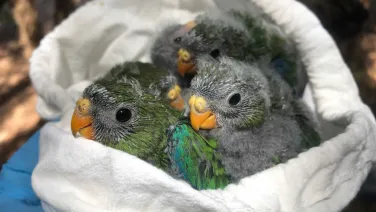New data confirms swift parrot population fears
A new evaluation from The Australian National University (ANU) of the number of swift parrots left in the wild has confirmed their population size is likely only a few hundred and declining rapidly.
A 2020 ANU study estimated the number could be as low as 300 – much lower than previously thought.
The researchers have now been able to reassess that estimate using new methods.

Co-author Dr Dejan Stojanovic said having a clear idea of population size is critical.
“The swift parrot is critically endangered – our conservation strategies depend on knowing how many birds are still alive in the wild,” he said.
“We need this information in order to work out how much time we have left to save them from extinction.
“We found that despite using a different method, we got a similar result – the new method just gave us a little more precision.”
As a second step, the researchers also updated their sample size of parrots to include a decade’s worth of data.
“By searching for nesting swift parrots over 10 years, we collected one of the largest genetic data sets for any threatened bird in Australia,” Dr Stojanovic said.
Co-author Dr George Olah added: "We can now say with confidence the current remaining population size is only about 500 parrots.”
“These results confirm we are running out of time to save the swift parrot. No matter which way you look at it, the number of surviving individuals is tiny.”
Swift parrots breed in Tasmania, but also migrate to mainland Australian each year looking for food.
This nomadic lifestyle makes them hard to count, which is why the researchers have turned to genetic techniques to estimate how many swift parrots are left.
“Swift parrots are declining in large part due to logging of their Tasmanian breeding habitat,” Dr Stojanovic said.
“Our results add to a mountain of evidence that swift parrots will go extinct unless we urgently change how we manage Tasmanian forests.”
The study has been published in Ecology and Evolution.
This article was first published by ANU Reporter.



